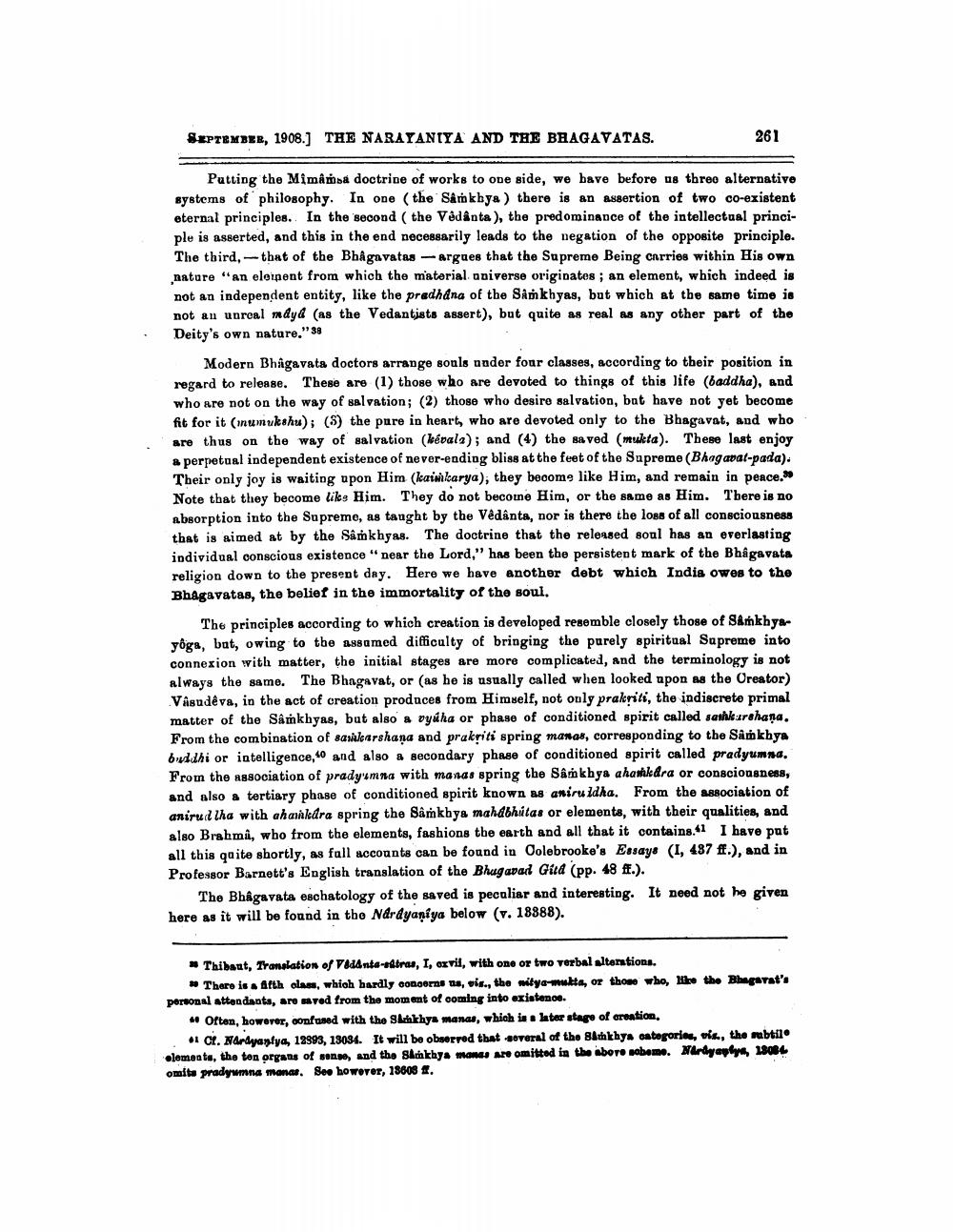________________
SEPTEMBER, 1908.) THE NARAYANIYA AND THE BHAGAVATAS.
261
Putting the Mimana doctrine of works to one side, we have before us three alternative systems of philosophy. In one (the Sâm khya ) there is an assertion of two co-existent eternal principles. In the second ( the Vêdânta), the predominance of the intellectual principle is asserted, and this in the end necessarily leads to the negation of the opposite principle. The third,--that of the Bhagavatas - argues that the Supreme Being carries within His own nature "an eloinent from which the material universe originates ; an element, which indeed is not an independent entity, like the pradhana of the Sankhyas, but which at the same time is not an unreal mdyd (as the Vedantists assert), but quite as real as any other part of the Deity's own nature."38
Modern Bhagavata doctors arrange souls ander four classes, according to their position in regard to release. These are (1) those who are devoted to things of this life (baddha), and who are not on the way of salvation; (2) those who desire salvation, but have not yet become fit for it (inumukohu); (8) the pure in heart, who are devoted only to the Bhagavat, and who are thus on the way of salvation (kévala); and (4) the saved (mukta). These last enjoy a perpetual independent existence of never-ending bliss at the feet of the Supreme (Bhagavat-pada). Their only joy is waiting upon Him (kainkarya); they become like Him, and remain in peace.” Note that they become like Him. They do not become Him, or the same as Him. There is no absorption into the Supreme, as taught by the Vedanta, nor is there the loss of all consciousness that is aimed at by the Sâmkhyas. The doctrine that the released soul has an everlasting individual conscious existence" near the Lord," has been the persistent mark of the Bhagavata religion down to the present day. Here we have another debt which Indis owes to the Bhagavatas, the belief in the immortality of the soul.
The principles according to which creation is developed resomble closely those of Samkhyayoga, bat, owing to the assumed difficulty of bringing the purely spiritual Supreme into connexion with matter, the initial stages are more complicated, and the terminology is not always the same. The Bhagavat, or (as he is usually called when looked upon as the Creator) Vasudeva, in the act of creation produces from Himself, not only prakrili, the indiscreto primal matter of the Så mkhyas, but also a vyáha or phase of conditioned spirit called sankarshana. From the combination of sasharshana and prakriti spring manas, corresponding to the Samkhya buddhi or intelligence, and also a secondary phase of conditioned spirit called pradyumna. From the association of pradyumna with manas spring the Sân khya ahamikdra or consciousness, and also a tertiary phase of conditioned spirit known as aniru idha. From the association of anirud lha with ahamikdra spring the Samkhya mahabhitas or elements, with their qualities, and also Brahma, who from the elements, fashions the earth and all that it contains.1 I have pat all this quite shortly, as fall accounts can be found in Colebrooke's Essays (I, 487 ff.), and in Professor Barnett's English translation of the Bhugavad Gita (pp. 48 ff.).
The Bhagavata eschatology of the saved is peculiar and interesting. It need not he given here as it will be found in the N&rdyaniya below (v. 18888).
* Thibaut, Translation of Vanta-abras, I, oxvil, with one or two verbal altentions.
# There is Afth olas, which hardly concerns no vis., the witya-mukta, or those who, like the Bhagavat's personal attendants, are saved from the moment of coming into existence.
- Often, however, confused with the Sinkhya manas, which is later stage of creation,
. Cl. Nandyayłya, 12993, 13034. It will be observed that soveral of the Bathkhya aategories, vis, the rabtil elements, the ton organs of sine, and the skinkhya mands Are omitted in the aborosobem. Nerdyalys 18084 omite pradyumna monat. See however, 18608 .




